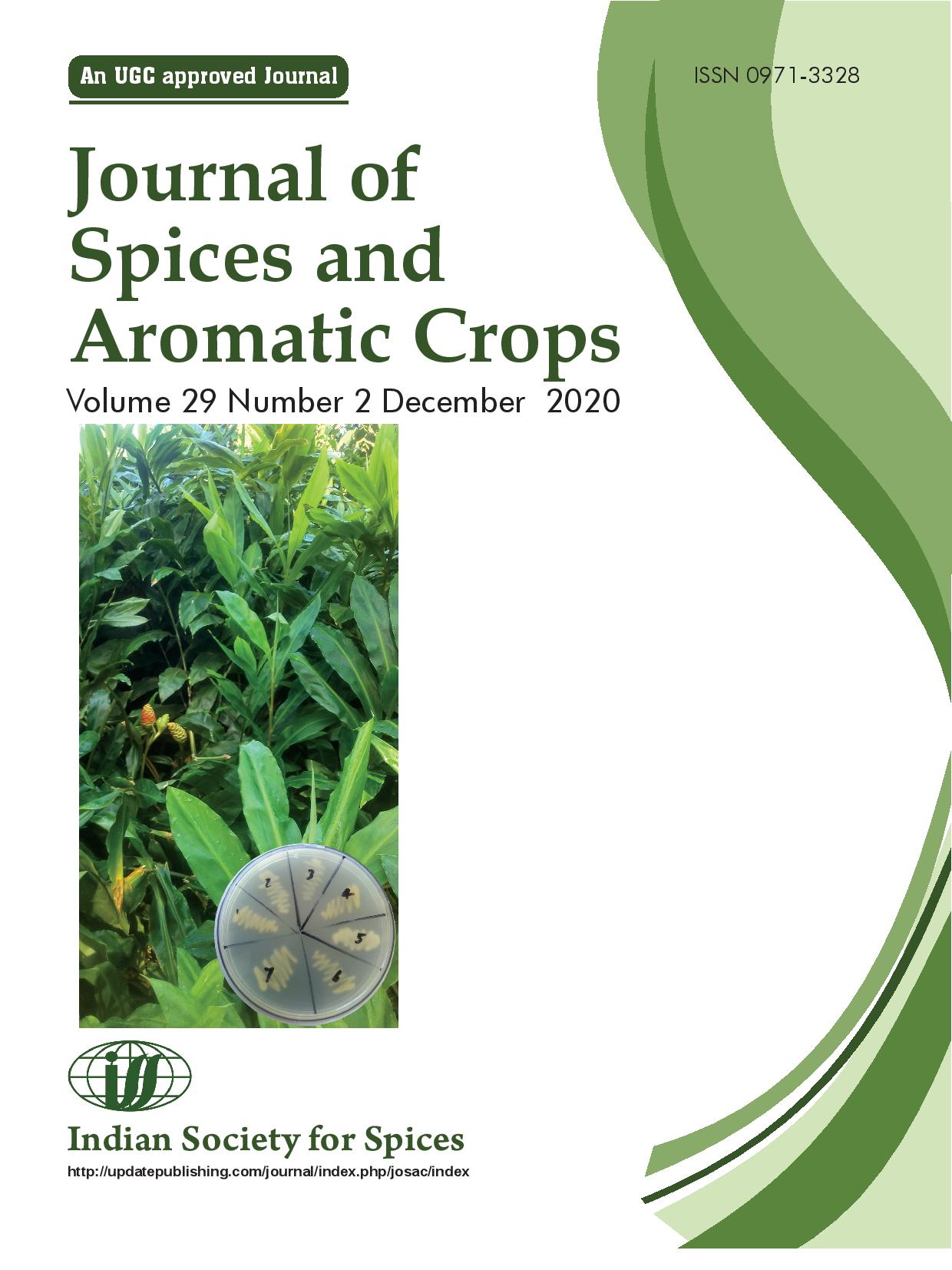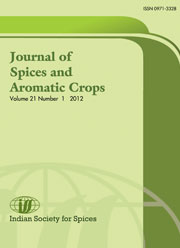Genetic variability, correlation and path analysis in tamarind (Tamarindus indica L.)
DOI:
https://doi.org/10.25081/josac.2020.v29.i2.6860Keywords:
GCV, heritability, PCV, tamarind genotypes, yield traitsAbstract
The present study was conducted at the Horticultural College and Research Institute, Periyakulam with the objective to estimate the extent of genotypic and phenotypic coefficient of variation, correlation and path analysis among tamarind genotypes. A remarkable variability was observed among the tamarind collections for all the characters. In all the cases, phenotypic variance was higher than the genotypic variance. Also, phenotypic coefficient of variation was found higher than genotypic coefficient of variation for all the traits. The high heritability coupled with high genetic advance as per cent over mean was observed in the traits such as pod yield plant-1 (98.07%; 76.103%), fruit weight (89.11%; 63.668%), fibre weight (89.95%; 91.967%), shell weight (86.19%; 58.534%) and pulp weight (74.13%; 51.533%) whereas the lowest values were recorded for pod length (34.91%; 13.945%) and tree circumference (20.34%; 8.198%). Thus, it indicated better scope for improvement of these traits through selection programme. Pod yield tree-1 was significantly and positively correlated with pod width, tree circumference and pulp weight. Path coefficient analysis showed that pod yield tree-1 contributed the maximum positive direct effect.
Downloads
References
Anonymous 2017 Area and production of spices in India. Spices Board, Cochin, Kerala.
Archana P, Kukanoor L, Prabhuling G & Praveen J 2013 Standardization of methods for extraction of tamarind pulp. Karnataka J. Agric. Sci. 26: 570–571.
Arif A A, Swamy G S K, Naik N, Jagadeesha R C, Gangadharappa P M & Thammaiah N 2019 Genetic variability studies in tamarind (Tamarindus indica L.). Int. J. Curr. Microbiol. App. Sci. 8: 1929–1935.
Bhogave, Anilfanchu & Dalal S R 2017 Genetic variability and divergence studies in tamarind (Tamarindus indica L.). Ph.D. Thesis, Dr. Panjabrao Deshmukh Krishi Vidyapeeth, Akola, Maharashtra.
Biradar S 2001 Evaluation of different tamarind (Tamarindus indica L.) genotypes. M.Sc. (Hort.) Thesis, University of Agricultural Sciences, Dharwad.
Burton G W & De Vane E W 1953 Estimating heritability in tall fescue (Festuca arundinacea) from replicated clonal material. Agron. J. 45: 478–481.
Challapilli A P, Chimmad V P & Hulamini N C 1995 Studies on correlation of some fruit characters in tamarind fruits. Karnataka J. Agric. Sci. 8: 114–115.
Dewey D R & Lu K A 1959 Correlation and path-coefficient analysis of components of crested wheatgrass seed production. Agron. J. 51: 515–518.
Divakara B N 2008 Variation and character association for various pod traits in Tamarindus indica L. Indian Forester. 15: 687–695.
Hanson C H, Robinson & Comstock R E 1956 Biometrical studies of yield in segregating populations of Korean Lespedeza. Agron. J. 48: 268–375.
Johnson H W, Robinson H F & Comstock R E 1955 Estimates of genetic and environmental variability in soybean. Agron. J. 47: 314–318.
Karale A R, Wagh A P, Pawar B G & More T A 1999 Association of fruit characters in tamarind. J. Maharashtra Agric. Univ. 24: 319–320.
Keskar B G, Karale A R, Dhwale B C & Choudhari K G 1989 Improvement of tamarind by selection. Maharashtra J. Hort. 4: 121–124.
Kulkarni R S, Kumar B M K, Swamy G S K, Gangaprasad S & Dushyanthakumar B M 1995 Path analysis of pulp yield in tamarind (Tamarindus indica) across provenances of Karnataka. J. Non-Timber Forest Prod. 2: 157–159.
Mayavel A, Nagarajan B, Muthuraj K, Nicodemus A & Prabhu R 2018 Correlation and path coefficient analysis of selected red tamarind (Tamarindus indica var. rhodocarpha) genetic resources. Int. J. Curr. Microbiol. App. Sci. 7: 794–802.
Nas S 1979 In: Tropical Legumes: Resources for the Future (pp.117–121). Washington DC.
Panse V G & Sukhatme P V 1985 Statistical methods for agricultural workers. 2nd edition, ICAR, New Delhi.
Patil S S 2004 Genetic and propagation studies in tamarind (Tamarindus indica L.). Ph.D. (Hort.) Thesis, University of Agricultural Sciences, Dharwad.
Prabhu R, Manivannan N, Mothilal A & Ibrahim S M 2015 Correlation coefficient analysis for yield and yield attributes in groundnut (Arachis hypogaea L.). Plant Arch. 15: 685–689.
Prasad S G, Nagaraj T, Kulkarni R S & Swamy G S K 1998 Correlation and path analysis in tamarind (Tamarindus indica. L.) across two diverse provinces of Southern Karnataka. J. Agric. Sci. 11: 227–229.
Prasad S G, Rajkumar S M H, Ravikumar R L, Angadi S G, Nagaraj T E & Shanthakumar G 2009 Genetic variability in pulp yield and morphological traits in a clonal seed orchard of plus trees of tamarind (Tamarindus indica L.). MyForest. 45: 411–418.
Purseglove J W 1987 Tropical crops. Dicotyledons, Longuma. Science and Technology. pp. 204–206.
Singh S, Singh A K & Joshi H K 2008 Genetic variability for floral traits and yield attributes in tamarind. Indian J. Hort. 65: 328–331.
Singh T R & Nandini R 2014 Genetic variability, character association and path analysis in the tamarind (Tamarindus indica L.) population of Nallur tamarind grove. SAARC J. Agric. 12: 20–25.









 .
.